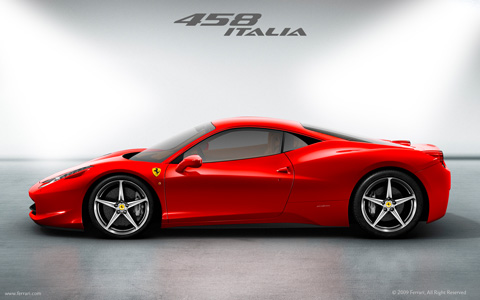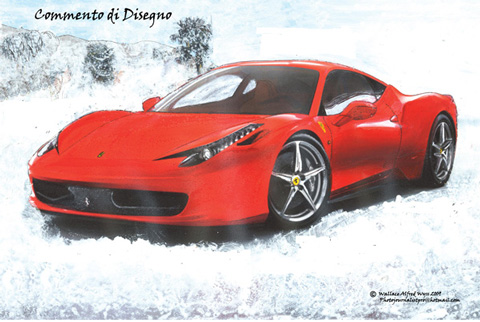
This week, what’s under the skin of the new Ferrari.
What we know so far about the new Ferrari V8
By Wallace Wyss
Technically the new Ferrari 458 Italia advances the art of the road going mid-engined car by making it almost as fast as the Enzo at a much lower cost.
The 458 Italia is going to be marketed with an automatic, seven-speed dual-clutch transmission designed to increase performance and still deliver very smooth shifts even at full throttle. The engineers have developed specific, sportier gear ratios to match the power and torque curves of the new V8, knowing that high torque is the key to acceleration even at lower engine speeds.
The high-revving 4498cc V8 has very light internal parts and small piston skirts, resulting in low rotation inertia and a 12.5:1 compression ratio. Ferrari rates it at 562 bhp at 9000rpm, the new engine power peak is 500rpm higher than that of the old 430. It is a little scary to think of routinely running a car about 3000 rpm faster than a Corvette’s redline.
For acceleration,
Ferrari claims 0 to 62 mph can be accomplished in under 3.4sec while top speed has been quoted in one source at 202 mph. The old 427 Cobra of the Sixties did 0-60mph in 4.2 seconds so the new Ferrari is faster than a Cobra 427 and in top end, way faster because of all the aero work.
Ferrari brings back the direct injection fuel system, which they first ran on the front-engined California. The move to direct injection is not only a search for more power (roughly 10%), but also to reduce emissions by at least 40% while improving fuel economy. Ferrari knows it is on the continent where the Greens rule and are trying to make their cars more environmentally friendly. The only trouble is that while new technology is expected to drop Ferrari’s C02 emissions from its current 400 g/km to 250 g/km, Ferrari still won’t meet the proposed European emissions regulations of 120 g/km by 2012, so basically what we have here is an exotic automaker’s right to exist vs. the ambitions of the Greens. We have two years to see who blinks first.

Nobody who buys a car like this worries about fuel consumption but for those who care, it is 13.7 liters per 100km on a combined cycle–good in its class. Calculated in American terms, it gets about 17 mpg.
The interior shows the benefits of having F1 champion Michael Schumacher test drive it during development, with the handling, cockpit layout, and even the shape of the steering wheel all benefiting from the input of Schumacher. With a weight balance of 48/52 and a double-wishbone suspension in front and multilinks in the rear, the 458 Italia’s handling will be what they call “race-ready,” though one can bet there will be special models offered to make it more race ready than they claim it already is One thing Ferrari doesn’t mention so far is the luggage capacity which makes one wonder–where is that luggage compartment, anyway? I still remember the Ford GT of ’05-’06 which the purists at Ford made with no trunk, front or back, a decision hardly fitting the definition of “grand touring.” Perhaps they plan on offering a fitted luggage option.
The frame is made of aluminum , with Ferrari working with Alcoa , who built a factory in Italy to supply the chassis. Ferrari says it weighs 3,043 lbs dry (you can add extra 100 to 200 lbs with all fluids topped off).
Back is the ”E-Diff differential and F1-Trac traction control systems both of which permit the new car to get 32% more power to the ground than in the old F430.
The aerodynamic package hasn’t been fully explained yet in the early press releases, though Ferrari already claims that the car can develop a solid 140kg of downforce at 200kph (124mph).The biggest trick revealed so far is deformable winglets in the grille cavity that gradually close up the radiator air intakes at speed, making the drag co-efficient drop. Another trick is some sort of air intakes that come off the bonnet and mate to the fenders, and also there’s some flush deck air intakes atop the front fenders as well as flush deck scoops in the back, taking in air. Some of these air intakes feed the engine cool air and some the brakes. It’s possible the rear deck scoops merely are an aerodynamic aid (the air exiting out the rear screens) but Ferrari’s press release does not explain this. (We’ve asked Ferrari about this and are waiting for an answer).
Once the underside of the car is shown, there will be a lot more known about how the car can reach over 200 mph and still be rock steady stable . There are venturi tunnels visible at the tail, and no doubt some attempt to control air flowing under the car that starts right at the front of the car. This is the famous “fifth surface” automakers talk about, not so important for 99 percent of the cars on the market, but when you are talking about a 200mph vehicle, what’s underneath is very important to directional stability and safety. It’s possible that they have controlled airflow through the body as an aid in handling downforce, similar to the McLaren F1–but that will be revealed in time.
In sum, all those who thought maybe Ferrari was “going soft” with cars like the new California, were wrong. With the 458 Italia, Ferrari is proving that they are on the cutting edge of GT car design. Of course the prices keep rising as they keep adding new technology ,but we are talking operating in a rarified atmosphere here, where cost is no object if you can deliver the goods. Ferrari does.
I would like to be able to submit to you some articals about my Fiat Grande Punto Sport Abarth Tarmack rally car. We have hads some stories published in Auto Italia Mag, UK Race Mag in Australia, but love to tell some of your readers about my littele Diesel rally car that has now 2 years in a row won the Diesel class at Targa Tasmaina and In 2008 finished Sec O/R in the 2Wd showroom class & 3Rd O/R in 2009 against the Might of Factory Run Mazda MPS3 driven by Top Factory Works drivers.
Please take a look at my web sight http://www.bitsofitaly.com
Best regards Phil B
Your mentioning underbody air flow control brings to mind the Lotus Elite I had almost 50 years ago. The underside of that car was as well finished as the top and perfectly smooth resulting in VERY low aerodynamic drag. Kicking in the clutch at 90 MPH resulted in only a slight retardation rate and 40+ MPG on the highway was not unknown. It was the Series One, Stage One, single S.U., FWE Climax powered model.
A Beautiful and exciting car. It befits the name “Italia” which has been used by some stunning cars in the past. I own a 1971 Intermeccanica Italia. As for the 458 Italia, get yours now while they may still be grandfathererd in under the new “Greeen” rules.
Bellissimo!
Another winner in the making? Where price is no object!
What a confusion of lumps and bumps.
Chris Bangel would have been proud of it.
A classic in the making it ain’t!
Must disagree with Cliff Barker.
This car has to be seen in live ! The lines are very, very clean and the most interesting parts of the body work is the aerodynamic sleek design related to the fresh air intakes for the engine compartment which are very sleek and well integrated and come without those enormous elephant ears “a la” Lambo or several enormous fans to keep the engine cool.
The only so-so part is the front air dam with the black-sprayed intakes and a “lost” prancing horse stuck on —- a more traditional Ferrari style grill (how about a variation on the egg-crate, in stainless steel or aluminum) would have been more elegant in my opinion, but than opinions can clearly differ.
Chris Bangle was not involved (so I believe), but Chris must be given the kudos he deserves as an innovative designer with his own (OWN) style (the 2 seater BMWs are not his strongest design in my opinion, but the Mille Miglia kind of Retro Prototype shown by BMW some time ago certainly was an eye-catcher, again very innovative for the auto industry in many ways!
Am I the only one to see this? To me the 458’s design is comical if not infantile. I can’t help but see a cartoon in it, and I even wonder: are the designers at Ferrari playing a practical joke on us or have they completely lost any notion of aesthetic elegance and artistic lines?
First, seen from the side, this car looks terribly as if it had sort of melted or folded under an extreme braking strain, the back having weighed heavily onto the front, creasing the side panels – a true Tex Avery visual effect! Then, from the front it definitely looks like a growling frowning Buddha – it could be a marketing feature, knowing it probably won’t be allowed to be driven in Europe… Even the back is goofy, with its ridiculously small wide eyed tail lights and the jack-in-the-box mouth-like triple-exhaust pipes.
Having a cartoon look was OK for the Beetle because of it’s Hollywood career, and it was marketed to youngsters, but for a Ferrari it doesn’t work – unless they are planning on making more money on the model toys than on the actual cars, or perhaps what they are saying is: we are just making toys!